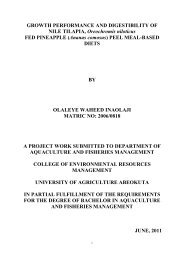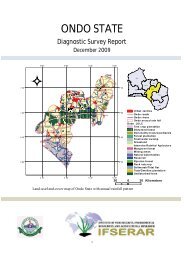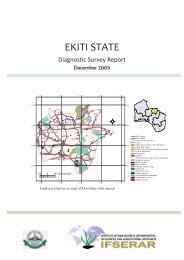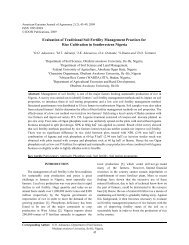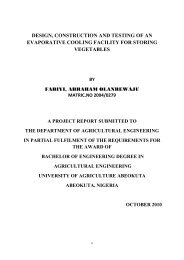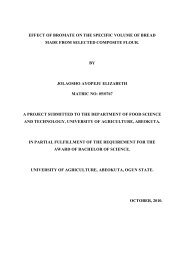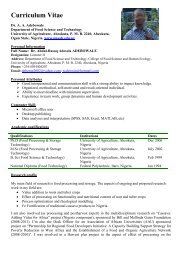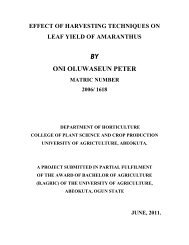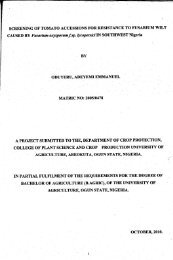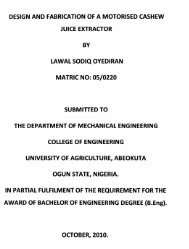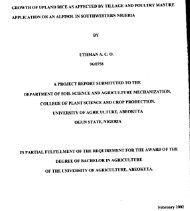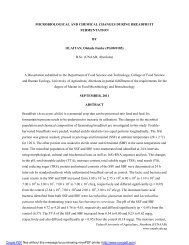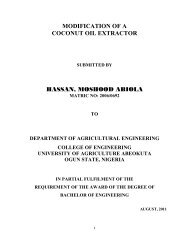EFFECTS OF ORGANIC FERTILIZERS ON GROWTH AND YIELD ...
EFFECTS OF ORGANIC FERTILIZERS ON GROWTH AND YIELD ...
EFFECTS OF ORGANIC FERTILIZERS ON GROWTH AND YIELD ...
Create successful ePaper yourself
Turn your PDF publications into a flip-book with our unique Google optimized e-Paper software.
<strong>EFFECTS</strong> <strong>OF</strong> <strong>ORGANIC</strong> <strong>FERTILIZERS</strong> <strong>ON</strong> <strong>GROWTH</strong> <strong>AND</strong> <strong>YIELD</strong> <strong>OF</strong><br />
MINT (Mentha piperita)<br />
BY<br />
DARAMOLA, OLUMIDE SAMUEL<br />
MATRIC. NUMBER: 06/1595<br />
SUBMITTED IN PATIAL FULFILMENT <strong>OF</strong> THE REQUIREMENTS FOR<br />
THE AWARD <strong>OF</strong> BACHELOR <strong>OF</strong> AGRICULTURAL SCIENCE<br />
DEPARTMENT <strong>OF</strong> HORTICULTURE<br />
COLLEGE <strong>OF</strong> PLANT SCIENCE <strong>AND</strong> CROP PRODUCTI<strong>ON</strong>,<br />
UNIVERSITY <strong>OF</strong> AGRICULTURE, ABEOKUTA, OGUN STATE<br />
JUNE, 2011
CERTIFICATI<strong>ON</strong><br />
This is to certify that this study titled “Effect of organic fertilizer on growth and yield of Mint<br />
(Mentha piperita)” carried out by DARAMOLA, Olumide Samuel with Matriculation number<br />
2006/1595 meets the regulation governing the award of Bachelor of Agriculture Science degree<br />
and is approved by the Department of Horticulture, University of Agriculture Abeokuta, Nigeria.<br />
Mrs T.T Joseph - Adekunle<br />
Date<br />
SUPERVISOR<br />
Prof. J. G. Bodunde<br />
Date<br />
HEAD <strong>OF</strong> DEPARTMENT
DECLARATI<strong>ON</strong><br />
I hereby, declare that this project was written by me and it is a record of my own research work.<br />
It has not been presented in any previous application for degree of this or any other University.<br />
All citations and sources of information are acknowledged by means of references.<br />
_________________________<br />
DARAMOLA Olumide Samuel<br />
_____________________<br />
Date
DEDICATI<strong>ON</strong><br />
This work is humbly dedicated to God Almighty who has always shown mercy unto me, all my<br />
benefactors and to all servants of God called to live and serve by faith, known or unknown, seen<br />
or unseen
ACKNOWLEDGEMENT<br />
I am grateful to my caring and loving parents Evangelist A.O and Mrs. V.F. Daramola, who<br />
have proved to be virtuous in giving to me their unrelenting financial, moral and spiritual<br />
supports throughout my academic programme in the University.<br />
My profound gratitude also goes to my supervisor, Mrs T.T Joseph-Adekunle for her love<br />
and motherly care to me from the commencement of the programme to its completion.<br />
I also appreciate the unflinching support of the Head of department Prof. J.G. Bodunde and<br />
all the lecturers of the Department of Horticulture Dr M.O Okelana, Dr. A. W. Salau, Dr. L .A<br />
Hammed, Dr. Makinde, DR. Olubode, Mr. M.O Olosunde and Dr. Mrs P.M Olorunmaye, from<br />
the Department of Plant Physiology and Crop Production, who have contributed towards the<br />
successful completion of my study from the department. I also appreciate the assistance of Dr.<br />
(Mrs) Bodunde (GREEC)<br />
Special thanks to my friends especially Popoola, Ibukun Olukorede, Bayo, Tolani, Debo,<br />
Temiloluwa, Tola, Taiwo Muyiwa, Funmibi, Hannah, Hellen.<br />
Finally my heartfelt gratitude goes to my siblings, Esther, Tosin and Tope for their love,<br />
support and care.<br />
May God bless you all.
ABSTRACT<br />
A pot experiment was conducted to determine the effect of Tithonia compost and<br />
Organomineral-fertilizers on the growth and yield of Mint (Mentha piperita). Mint vine cuttings<br />
of 3cm were planted into 5kg soil with 1kg, 2kg Tithonia and 250g, 500g Organomineralfertilizers<br />
application respectively. Application of organomineral fertilizer and tithonia compost<br />
significantly enhanced vegetative growth parameters, the fresh as well as dry weight of Mint.<br />
The effect was maximal with the application of 500g organomineral fertilizer with respect to the<br />
number of leaves, number of tendrils and the dry weight as compared with other application<br />
rates. However, application of 2kg tithonia enhanced vine growth better compared to other<br />
treatments. Similar trend was also obtained for the yield/ biomass production of Mentha piperita.<br />
Application of 1kg, 2kg tithonia compost and 250g, 500g, organomineral fertilizer gave a better<br />
biomass yield as compared with the control. However, Application of 250g and 500g of<br />
organomineral fertilizer produced the same response with respect to dry weight as there was no<br />
significant difference between the two application rates.
CHAPTER <strong>ON</strong>E<br />
INTRODUCTI<strong>ON</strong><br />
1.0 Introduction<br />
Mentha is a genus of aromatic perennial herbs belonging to the family Lamiaceae, of over 200<br />
genera distributed mostly in temperate and sub-temperate regions of the world. The number of<br />
taxonomically valid species in the genus remains a matter of speculation as members freely cross<br />
amongst themselves, producing many intermediary forms(Hedge, 1992, Dorman etal 2003).<br />
Most of the commercially important mints are hybrids. Mentha piperita, the peppermint, is a<br />
sterile first generation hybrid between M. spicata and M. aquatica (Hefendehl and Murray,<br />
1972).<br />
Several mints of species are industrial crops, a source of essential oils enriched in certain<br />
monoterpenes that are widely used in food, flavour, cosmetic and pharmaceutical industries.<br />
Also different species of mint are used across the globe for their medicinal and culinary<br />
properties. Mint is usually taken after a meal for its ability to reduce indigestion and colonic<br />
spasms by reducing the gastrocholic reflux. Less well recognized is peppermint’s potential role<br />
in the management of numerous medical problems, including colonoscopy (Spirling and<br />
Daniels,2001). Peppermint oil is the major constituent of several over the counter remedies for<br />
symptoms of irritable bowel syndrome (IBS). Results of clinical trials indicated that it could be<br />
efficacious for relief in IBS (Pittler and Ernst, 1998)<br />
The genus Mentha has a large number of species that differ widely in their characteristics and<br />
ploidy level. Since they are often perennial and produce suckers, Mentha species reproduce both
y reproductive and vegetative means. However, the purity of cultivars is maintained by<br />
vegetative means of propagule generation. Mint species are widely distributed and are prone to<br />
attack by a variety of diseases and pests.<br />
Plate 1<br />
Mint plant (pineapple mint)
Plate 2 Mint plant (Mentha piperita)
Plate 3 Mint plant (Spear mint)
Plate 4 Chocolate Mint in the garden
1.3 Important Mint species<br />
Commercially, the most important mint species are peppermint (M. piperita), spearmint (M.<br />
spicata), and corn mint (M. canadensis.). From these species, corn mint is cultivated only<br />
because of oil production (Small 1997, Oudhia 2003). Peppermint (M. piperita.) oil is one of the<br />
most popular and widely used essential oils, mostly because of its main components menthol and<br />
menthone (Gul 1994). Corn mint is the richest source of natural menthol (Sharma & Tyagi 1991,<br />
Shasany et al. 2000). Peppermint oil is used for flavouring pharmaceuticals and oral<br />
preparations, such as toothpastes, dental creams, and mouth washes. It is also used as a<br />
flavouring agent in cough drops, chewing gums, confectionery and alcoholic liqueurs. It is used<br />
in medicines for internal use. Its pleasant taste makes it an excellent gastric stimulant (Budavari<br />
et al. 1989, Gupta 1991).<br />
1.4 Uses of Mint species<br />
Peppermint oil is used for flavouring pharmaceuticals and oral preparations, such as toothpastes,<br />
dental creams, and mouth washes. It is also used as a flavouring agent in cough drops, chewing<br />
gums, confectionery and alcoholic liqueurs. It is used in medicines for internal use. Its pleasant<br />
taste makes it an excellent gastric stimulant (Budavari et al. 1989, Gupta 1991). Mint leaf, fresh<br />
or dried, is the culinary source of mint. Fresh mint is usually preferred over dried mint when<br />
storage of the mint is not a problem. The leaves have a pleasant warm, fresh, aromatic, sweet<br />
flavor with a cool aftertaste. Mint leaves are used in teas, beverages, jellies, syrups, candies, and<br />
ice creams. In Middle Eastern cuisine, mint is used on lamb dishes, while in British cuisine and
American cuisine, mint sauce and mint jelly are used, respectively. Mint is a necessary<br />
ingredient in Touareg tea, a popular tea in northern African and Arab countries. Alcoholic drinks<br />
sometimes feature mint for flavor or garnish.<br />
The substances that give the mints their characteristic aromas and flavors are menthol (the main<br />
aroma of Peppermint and Japanese Peppermint) and pulegone (in Pennyroyal and Corsican<br />
Mint). The compound primarily responsible for the aroma and flavor of spearmint is R-carvone.<br />
Mints are used as food plants by the larvae of some Lepidoptera species including Buff Ermine.<br />
Other important uses of Mint include<br />
Medicinal and cosmetic<br />
Mint was originally used as a medicinal herb to treat stomach ache and chest pains, and it is<br />
commonly used in the form of tea as a home remedy to help alleviate stomach pain. During the<br />
Middle Ages, powdered mint leaves were used to whiten teeth. Mint tea is a strong diuretic.<br />
Menthol from mint essential oil (40%–90%) is an ingredient of many cosmetics and some<br />
perfumes. Menthol and mint essential oil are also much used in medicine as a component of<br />
many drugs, and are very popular in aromatherapy. Menthol is also used in cigarettes as an<br />
additive, because it blocks out the bitter taste of tobacco and soothes the throat. The strong, sharp<br />
flavor and scent of mint is sometimes used as a mild decongestant for illnesses such as the<br />
common cold. In Rome, Pliny recommended that a wreath of mint was a good thing for students<br />
to wear since it was thought to "exhilarate their minds".
Insecticides<br />
Mint leaves are often used by many campers to repel mosquitoes. It is also said that extracts from<br />
mint leaves have a particular mosquito-killing capability. Mint plants planted near doorways help<br />
drive ants away. Mint oil is also used as an environmentally-friendly insecticide for its ability to<br />
kill some common pests like wasps, hornets, ants and cockroaches.<br />
Aromatherapy<br />
Known in Greek Mythology as the herb of hospitality, one of the first known uses for mint in<br />
Europe was as a room deodorizer. The herb was strewn across floors to cover the smell of the<br />
hard-packed soil. Stepping on the mint helped to spread its scent through the room. Today, it is<br />
more commonly used for aromatherapy through the use of essential oils.<br />
1.4 Justification<br />
Though Mint is a temperate crop, some species have been found to be adaptable to the tropical<br />
environment. The inherent uses could however be exploited in tropical environment, hence the<br />
study was conducted to access the effect of organic fertilizer which is readily available, cost<br />
effective and environmentally safe on the growth and yield of Mint.<br />
1.5 Objectives<br />
<br />
<br />
To evaluate the effect of organic fertilizers on the growth of Mint<br />
To access the effect of organic fertilizer rates on herbage yield of Mint
CHAPTER TWO<br />
LITERATURE REVIEW<br />
2.0 Origin and distribution of mint species<br />
Mint descends from the Latin word mentha, which is rooted in the Greek word minthe,<br />
personified in Greek mythology as Minthe, a nymph which was transformed into a mint plant.<br />
The word itself probably derives from a now extinct pre-Greek language. In Central and South<br />
America, mint is known as hierbabuena (literally, "good herb"). In Lusophone countries,<br />
especially in Portugal, mint species are popularly known as Hortelã. In many Indo-Aryan<br />
languages, it is called Pudīna. The taxonomic family Lamiaceae is known as the mint family. It<br />
includes many other aromatic herbs, including most of the more common cooking herbs,<br />
including basil, rosemary, sage, oregano, and catnip.<br />
The genus Mentha (Laminaceae) is composed of 19 geographically widespread species and 13<br />
named hybrids (Chambers & Hummer 1994). Peppermint, M. x piperita, is native to Europe and<br />
it has become both cultivated and naturalised in the USA, India, China, the former USSR, Italy,<br />
France and Hungary. Its essential oil is considered industrially important (Lawrence 1985,<br />
Tucker 1992).
Mentha is distributed mostly in temperate and sub-temperate regions of the world. The number<br />
of taxonomically valid species in the genus remains a matter of speculation as members freely<br />
cross amongst themselves, producing many intermediary forms. Polyploidy has also played an<br />
important role in the process of speciation in this genus. Most of the commercially important<br />
mints are hybrids or amphiploids. M. piperita, the peppermint, is a sterile first generation hybrid<br />
between M. spicata and M. aquatica (Hefendehl and Murray, 1972).<br />
Mint cultivation is widely distributed. The United States of America is the main producer of<br />
peppermint and spearmint oils. The peppermint (M. piperita) is cultivated on a large scale in the<br />
states of Oregan, Indiana, Idaho, Ohio and Michigan (Chambers and Hummer, 1992), 12 Bhat et<br />
al. whereas spearmint cultivation is localized in Indiana and Michigan. Spearmint is also<br />
cultivated in France, the United Kingdom, Italy, Yugoslavia, Hungary, Bulgaria, Russia, South<br />
Africa, Thailand and Vietnam. Bergamot mint is commercially cultivated in China, Taiwan and<br />
India, and menthol or Japanese mint in India, China, Taiwan, Thailand, Japan and Brazil.<br />
2.1 Mint essential oil compositions<br />
Mints are cultivated for their essential oils, yielded by distillation of over-ground herbaceous<br />
foliage. The oil contains a large variety of aromatic chemicals in varying composition. The oils<br />
and their fractions are in great demand world-wide. Peppermint (Mentha x piperita L.) oil is one<br />
of the most popular and widely used essential oils, mostly because of its main components<br />
menthol and menthone. flavouring. mint is the richest source of natural menthol (Sharma &<br />
Tyagi 1991, Shasany et al. 2000). Carvone-scented mint plants, such as spearmint (M. spicata),
are rich in carvone and are widely used as spices and cultivated in several countries (Kokkini et<br />
al. 1995).<br />
2.3 Cultivation<br />
Mints are mainly propagated vegetatively rather than by seeds. Only some mints, such as M.<br />
arvensis L., M. pulegonium L. and M. spicata L., are propagated by seed (Galambosi 1995).<br />
There are many reasons for the vegetative propagation of mint. According to Hornok (1992), the<br />
peppermint as a hybrid seldom produces seeds able to germinate. For this reason, propagation is<br />
used exclusively with vegetative parts such as green shoots, underground stolons and rooty<br />
turions. In cutting propagation, 10–15 cm long shoots are cut from the mother plant and lower<br />
leaves are removed. The shoots are planted in a growth medium consisting of a mixture of<br />
sterilized sand and peat. Critical factors are humidity and relative humidity of 95–98% for 2–4<br />
weeks. The temperature should be kept at 25–30o C. When the plants are rooted, they are ready<br />
for transfer outdoors (Galambosi 1995). The expenses and labour involved in, the cutting method<br />
of propagation make it unpopular for extensive cultivation (Hornok 1992). In cutting propagation<br />
during spring, the yield was 20–30% less than that in traditional propagation by underground<br />
stolons, though cutting propagation was more economical (Földesi & Havas 1979). When the<br />
apical stem (the apical 5 nodes of aerial stem), basal stem (the basal 5 nodes of aerial stem),<br />
sprouted stem (midstem carrying new auxiliary buds), green stolon (growing parallel to the soil<br />
surface) and etiolated rhizome (growing below the soil surface) were employed as the source of<br />
single-node cuttings, maximum rooting percentage was obtained using etiolated rhizome,<br />
followed by green stolons (EL-Keltawi & Croteau 1986). Propagation with green cuttings cannot
e utilized in the case of large-scale cultivation due to high costs and a high demand for manual<br />
labour (Hornok 1992). The propagation material, mostly used in the multiplication of<br />
peppermint, consists of stolons grown in the soil (white) or on the surface (green) or from 8–10-<br />
cm high turions developed from underground stolons (Hornok 1992). The satisfactory<br />
development of stolons during intensive cultivation is hindered by several known and unknown<br />
factors. The mass of roots increases with the age of the plant but the quantity of the liveable<br />
stolons decreases (Zambori & Tetenyi 1988). Propagation by stolons is the most popular method<br />
of mint propagation because it is the most economic. The mother plants are raised for the<br />
propagation material and then they are chopped, spread and covered with soil. In practice, this<br />
method succeeds in areas with long summers and in soil free of weeds, meaning that the use of<br />
herbicides is necessary. If propagation is carried out at the beginning of summer, only surface<br />
stolons (white) are used. The best size is 10–15 cm and best growth takes place in rows at a<br />
width and depth of 10 cm (1999 a). However, Pank (1974) noticed that chopping stolons before<br />
sowing significantly reduced the yield in comparison to 10–20 cm long stolons. The best result<br />
was obtained when the stolons were separated and divided in to pieces by hand from the roots.<br />
Nemeth & Pham (1995) studied the growth and development of the vegetative propagation<br />
organs (the stolons), and concluded that the stolon number is depended on the species and in all<br />
examined species the main of stolon branching occurs at the end of flowering.<br />
2.4 Soil pH and soil nutrients<br />
Cultivation techniques have a great influence on plant growth (biomass production) and the<br />
quality and quantity of secondary metabolites. Soil pH is an important chemical property that
profoundly affects the growth and nutrient uptake by crops (Fageria & Baligar 1999). According<br />
to Vander Wat et al., 1991, high acidity and low calcium severely impaired plant-root<br />
development. Lime can raise the pH of acidic soils (Tan 1994). Liming can have many other<br />
effects on the biochemical processes in the soil and on the yield and composition of different<br />
plant species and varieties (Stevens and Laughlin 1996). Soil pH affects the availability of<br />
several mineral nutrients, such as nitrogen, phosphorus, potassium, sulphur, calcium,<br />
magnesium, iron, manganese, boron, copper, zinc and molybdenum, and all of these nutrients are<br />
available in the pH range of 5.5 to 6.5 (Taiz & Zeiger, 1998). Loss of plant available phosphate<br />
in soils occurs by phosphate fixation, which is especially strong in acid mineral soils. Such losses<br />
can be dramatically reduced by liming soils to a pH of 6–7 (Konrad 1997). Different levels of<br />
soil Ph influenced the fresh and dry weight and the essential oil yield of peppermint (Shukla et<br />
al. 1997, 1998).<br />
Most authors report that significantly higher dry matter and essential oil yields for corn mint,<br />
peppermint and spearmint were obtained with higher nitrogen application but that the application<br />
of nitrogen did not affect the chemical composition of the essential oil (Atanasov et al. 1979,<br />
Clark & Menary 1980 b, Slavov 1985, Singh et al. 1989, Saxena & Singh 1995). Other authors<br />
have reported that a decrease in menthol and an increase in menthone and menthyl acetate in<br />
peppermint and corn mint has been found with increased application of N (Duhan et al. 1977,<br />
Duhan 1979, Hornok 1983). According to Kothari & Singh (1995), carvone and limonene<br />
concentrations in Scotch spearmint (M. gracilis) were affected by levels of N, and in general, an<br />
increase of N decreased carvone but increased limonene in oil. This is not quite in agreement<br />
with Singh & Singh (1986) who reported that the application of N increased carvone in
spearmint oil. Marotti and co-authors (1994) used different levels of nitrogen and phosphorus in<br />
peppermint trials. They reported that mineral fertilization seemed to increase the menthol content<br />
of essential oil compared with untreated plants. Hornok (1974), in an experiment with<br />
peppermint fertilization, stated that the most effect on yield was achieved first by the level of<br />
nitrogen and second by the level of calcium. Phosphorus fertilization had no effect on yield.<br />
However, a high quality of peppermint oil in any region requires the optimum use of fertilizer<br />
and water to maintain herbage growth and delay maturity as long as possible so that the herbage<br />
may be harvested with a minimum of flowers (Murray et al. 1988)<br />
2.5 Harvesting time<br />
Amount and composition of essential oil is strongly dependent on developmental stage of the<br />
plant (ontogeny), and therefore harvesting time is one of the most important factors influencing<br />
mint oil quality.<br />
Harvesting a crop early or late resulted in a low yield of leaves as well as the essential oil content<br />
because at an earlier or later stage of harvesting, the crop was immature or over mature resulting<br />
in a poor yield of herb and oil content (Shah & Gupta 1989). According to Chalchat and coauthors<br />
(1997), harvesting should be carried out after flowering to obtain oil that contains a high<br />
amount of menthol. Ulseth (1994) found that the poorest oil quality was obtained from mints that<br />
were in a stage of early blooming or were not yet blooming at all. Oil content in stems was very<br />
poor and present only in younger parts (Croteau & Gershenon 1994). According to Clark and<br />
Menary (1984), besides the timing of harvest, the numbers of harvests per year greatly influence<br />
yield, and composition of oil. The essential oil from the first harvest was richer in menthol than
that of the second harvest. In the second harvest all the leaves were young with a higher<br />
menthone and lower menthol content (Saxena & Singh 1995). Similarly, Court and co-authors<br />
(1993) found that the amount of menthol increased as the plant matured. According to Ram and<br />
Kumar (1999), there was a difference between the yield and quality of essential oil in seven mint<br />
cultivars in the first and the second harvest. For corn mint, the maximum oil content was reached<br />
during the flowering period; however, high temperature was found to decrease the oil yield<br />
(Duriyaprapan et al. 1986). According to Ram and Kumar (1999), the oil content of the first or<br />
second harvest of M. arvensis depends on the variety. The concentration of carvone in Scotch<br />
spearmint was higher in oil of the first harvest compared with the second harvest (Kothari &<br />
Singh 1995). There is a remarkable difference in oil composition between leaves at different age,<br />
especially juvenile and mature leaves (Duriyaprapan & Britten 1982). A greater proportion of oil<br />
is obtained from the leaves, especially from leaves at the upper part of the plant canopy, but not<br />
at the top because leaves at the age of 0–2 weeks contributed 16% of leaf dry matter compared<br />
with 27% of oil yield. This may explain why the maximum essential oil production of mint<br />
plants is attained during the flowering period when almost no top growth occurs. The<br />
intermediate and lower leaves reached their highest essential oil content at approximately the<br />
time when plants were starting to bloom. The upper leaf pairs completed their development after<br />
floral initiation (Burbott & Loomis 1967). According to Voirin and co-authors (1990), the young<br />
(apical) leaves of peppermint mainly contained menthofuran, pulegone and menthone. Menthol<br />
increased rapidly while menthone decreased in the older leaves. Menthone was higher in the<br />
young leaves and menthol appeared as the main component of the oldest leaf.
CHAPTER THREE<br />
MATERIALS <strong>AND</strong> METHOD<br />
3.0 Experimental location<br />
The experiment was conducted at the Fadama end of Organic Skill Demonstration Plot<br />
University of Agriculture, Abeokuta, Ogun state during the 2011 dry season.<br />
3.1 Materials<br />
Mint vines (obtained from FADAMA 2 vegetable growers in Iba Lasu Lagos State.), 15 pieces<br />
of 40cm diameter perforated bowls, topsoil, Tithonia compost from Organic farm and<br />
Organomineral fertilizer from Sunshine Organic Company Akure.<br />
3.2 Methods<br />
Soil and fertilizer analyses were carried out to determine the physical chemical properties Thirty<br />
Core samples soil were taken from 0 -30 cm depth buked together, and representative sample<br />
taken for analysis. Samples of both the Orgarnomineral and tithonia based compost fertilizer<br />
were also analysed. The Mint vines were cut into bits of of 3cm, the pots were filled with 5kg<br />
sieved soil and the fertilizers at the different rates homogenized with it. The mixture was watered<br />
and allowed to stabilize for about a week. The cuttings were then planted into pots (40 cm in<br />
diameter) and watered and growth and yield were monitored for 14 weeks. Fresh herbage yield<br />
and dry weight were determined at the end of the 14 weeks. After the harvest, the fresh herbage
yield was weighed and oven - dried (at 65 0 C) for 72hour. The dry matter weight determination<br />
was done using the sensitive weigh scale.<br />
3.3 Experimental design<br />
The experimental design was Completely Randomized design (CRD) with three replicates. The<br />
treatments were 1kg, 2kg of Tithonia compost fertilizer and 250g, 500g of Organomineral<br />
fertilizer and control.<br />
3.4 Data collection and Statistical analysis<br />
The parameters assessed weekly were the number of leaves, the number of tendrils (by count)<br />
and the vine length using tape measure. Data collection started 4 weeks after planting.<br />
Data collected were subjected to analyses of variance (ANOVA) and the separations of the<br />
significant treatment means were done using the least significance difference at (LSD) at 5%<br />
level.
CHAPTER FOUR<br />
RESULTS <strong>AND</strong> DISCUSSI<strong>ON</strong><br />
The experiment was conducted on a loamy sand soil with pH 6.80 containing N 0.45%, K<br />
0.75%, Ca 8.78Cmol, Mg 2.62Cmol, Na 0.06 Cmol .<br />
The Organomineral fertilizer and tithonia compost had pH of 8.10 and 6.30 respectively.<br />
N(2.66%), (0.61%) respectively. The Organomineral fertilizer also contain P(2.19%), k(1.34%),<br />
Ca(2.14%), Na(0.15%), Mg(1.07%), Organic carbon (47.00%), Fe(0.49%), Zn(247.00mg/l),<br />
Mn(428.5mg/l), Cu(93.75mg/l) and SO4(1.27mg/l) e.t.c (Table 1)
Table 1: Soil and fertilizer physical and chemical properties<br />
Nutrient Soil Tithonia Organomineral<br />
N (%) 0.45 0.61 2.66<br />
A.P (mg/kg) 39.00 69.00 2.19%<br />
K (Cmol) 0.05 0.19 1.34%<br />
Particle size (%)<br />
Sand 7.75 85.50<br />
Silt 19.20 11.70<br />
Clay 2.80 2.80<br />
Base Saturation (%) 99.05 99.85<br />
Micro-nutrient<br />
Cu(mg/kg) 0.38 0.58 93.75<br />
Zn(mg/kg) 0.13 4.48 24.7<br />
Fe(mg/kg) 3.30 0.98 0.49<br />
Mn (mg/kg) 5.00 12.6 428.5<br />
pH(mg/kg) 6.80 6.30 8.10<br />
CEC(Cmol) 11.61 8.26
4.0 Number of leaves<br />
Number of leaves increased with age from 4WAP to 10WAP. Application of 500g<br />
organomineral fertilizer gave the highest number of leaves, which was significantly different<br />
from application of 250g organomineral fertilizer (p≤0.05). Similarly, application of 2kg tithonia<br />
was significantly different from application of 1kg tithonia. There was no significant difference<br />
between the application of 2kg tithonia compost and 250g organomineral fertilizer (Table 2)<br />
4.1 Vine length<br />
Vine length increased from 4WAP to 10WAP. Application of 250g organomineral fertilizer gave<br />
the longest mean vine length. There was no significant difference between the application of<br />
250g orgarnomineral and 500g organomineral on the mean vine length (p≤0.05). Conversely,<br />
there was significant difference between application of 1kg and 2kg tithonia base compost.<br />
However, there was no significant difference between all the rates of application between 7WAP<br />
and 9WAP until the 10WAP (p≤0.05) (Table 3)<br />
4.2 Number of tendrils<br />
Application of 500g organomineral fertilizer gave the highest number of tendrils, but was not<br />
significantly different from application of 2kg tithonia fertilizer (p≤0.05). Application of 250g<br />
organomineral gave a significantly higher difference from application of 1kg tithonia. However,<br />
there was no ssignificant difference between application of 1kg tithonia and the control (p≤0.05).<br />
(Table 4)
4.3 Fresh weight<br />
Application of 500g organomineral gave the highest biomass yield, which was significantly<br />
different from application of 250g organomineral fertilizer (p≤0.05). Conversely, there was no<br />
significant difference between the application of 500g organomineral and 2kg tithonia base<br />
compost fertilizer. However, all fertilizer application rates were significantly different from the<br />
control (p≤0.05) (Table 5)<br />
4.4 Dry weight<br />
Application of 500g and 250g organomineral did not differ significantly with respect to dry<br />
weight. (p≤0.05). Similarly, There was no significant difference between the application of 1kg<br />
and 2kg tithonia base compost fertilizer. However, all application rates were significantly<br />
different from the control experiment (p≤0.05) (Table 6)
Table 2: Effect of organic fertilizer on the number of leaves of mint (Mentha piperita)<br />
Treatments/pot 4WAP 5WAP 6WAP 7WAP 8WAP 9WAP 10WAP<br />
Control 74.3 a 88.0 ab 148.3 c 170.6 c 187.3 b 203.0 b 215.3 c<br />
1kg T 39.0 b 61.0 b 167.3b c 203.3 bc 223.3 b 247.6 b 268. 6bc<br />
2kg T 82.3 a 121.6 a 248.0 a 308.6 ab 403.3 a 422.3 a 422.6 a<br />
250g OMR 96.3 a 131.3 a 218.3 ab 270.6 ab 392.6 a 319.6 ab 356.3 ab<br />
500g OMR 88.0 a 116.3 a 148.3 c 283.3 a 392.6 a 413.3 a 438.3 ac<br />
Means in the column with different letters are significantly different (p≤0.05).
Table 3: Effect of organic fertilizers on vine length of Mint (Mentha piperita)<br />
Treatments/pot 4WAP 5WAP 6WAP 7WAP 8WAP 9WAP 10WAP<br />
Control 74.3 a 88.0 ab 148.3 c 170.6 c 187.3 b 203.0 b 215.3 c<br />
1kg T 39.0 b 61.0 b 167.3 bc 203.3 bc 223.3 b 247.6 b 268.6 bc<br />
2kg T 82.3 a 121.6 a 248.0 a 308.6 ab 403.3 a 422.3 a 422.6 a<br />
250g OMR 96.3 a 131.3 a 218.3 ab 270.6 ab 392.6 a 319.6 ab 356.3 ab<br />
500g OMR 88.0 a 116.3 a 148.3 c 283.3 a 392.6 a 413.3 a 438.3 ac<br />
Means in the column with different letters are significantly different (p≤0.05).
Table 4: Effect of organic fertilizer on numbers of tendrils of Mint (Mentha piperita)<br />
Treatments/pot 4WAP 5WAP 6WAP 7WAP<br />
8WAP 9WAP 10WAP<br />
Control 5.0 a 9.3 b 13.3 b 24.6 b 27.6 b 33.0 b 35.6 b<br />
Tithonia (1kg) 3.6 a 6.3 c 15.0 b 25.0 b 32.0 b 33.0 b 36.0 b<br />
Tithonia(2kg) 5.3 a 9.6 b 18.3 ab 31.3 a 35.3 ab 37.3 ab 41.3 ab<br />
OMR(250g) 6.0 a 13.0 a 24.0 a 43.6 a 48.0 a 52.0 a 55.3 a<br />
OMR(500g) 5.6 a 10.0 b 20.3 ab 31.3 ab 38.0 a 44.3 ab 47.6 ab<br />
Means in the column with different letters are significantly different (p≤0.05).
Table 5: Effect of organic fertilizer on biomass yield of Mint (Mentha piperita)<br />
Treatment/pot<br />
Fresh weight(g)<br />
Control<br />
59.6 c<br />
Tithonia compost 1kg<br />
67.6 ab<br />
Tithonia compost 2kg<br />
71.6 a<br />
Organomineral 250g<br />
66.3 b<br />
Organomineral 500g<br />
68.6 a<br />
Means in the column with different letters are significantly different (p≤0.05).
Table 6:<br />
Effect of organic fertilizer on dry weight of Mint (Mentha piperita)<br />
Treatment<br />
dry weight(g)<br />
Control<br />
16.3 b<br />
Tithonia compost (1kg/pot)<br />
18.6 ab<br />
Tithonia compost (2kg/pot)<br />
18.6 ab<br />
Organomineral (250g/pot)<br />
20.6 a<br />
Organomineral (500g/pot)<br />
19.6 a<br />
Means in the column with different letters are significantly different (p≤0.05).
4.7 Discussion<br />
Mint plants are one of the most interesting research plants; they are between medicinal and<br />
aromatic plants. There is a numerous research on mint, however, only few reports are available<br />
on local environmental conditions (Aflatuni et al. 1999 a). Several mint species, origins and<br />
cultivars are cultivated around the world, but in this study only Mentha piperita..<br />
Many studies have reported the increase of yield with liming (Shukla et al. 1997, 1998, Ernani et<br />
al. 2002). In which the highest yield was achieved after the third year of liming with the liming<br />
of 4 or 8 t ha-1 (soil pH 6–6.5) in fine sand .The average yield for three years shows that liming<br />
with 4 t ha-1 gave almost the same yield as with 8 and 12 t ha-1.<br />
Matusiewicz (1972) studied peppermint of the Mitcham variety in five combinations of soil pH,<br />
ranging from 4.7 to 6.9 for 3 years. He concluded that the plants developed best and gave the<br />
highest crop of plant material at soil pH ranging from 5.6 to 6.2. However this study shows the<br />
effect of organic fertilizers on the growth and yield of Mintha piperita on soil of pH 6.8. From<br />
this study it was observed that Application of organic fertilizers such as organomineral and<br />
tithonia base compost fertilizer increased the growth parametars of Mint ( Mentha piperita) in<br />
terms of number of leaves, vine length, number of tendrils, as well as the fresh and dry weight.<br />
Such promoting effect was maximal with the application of 500g organomineral fertilizer with<br />
respect to the number of leaves, number of tendrils and the dry weight as compared with other<br />
application rates. Similarly, application of 2kg tithonia base compost fertilizer gave the highest<br />
effect with respect to vine length. Thus the application of 500g organomineral fertilizer result in<br />
positive impact on the biomass production of Mentha piperita. 1kg tithonia base compost and
250g organomineral fertilizer gave a better biomass yield as compared with the control<br />
experiment. Application of 250g and 500g of organomineral fertilizer produced the same<br />
response with respect to dry weight as there was no significant difference between the two<br />
application rates.
CHAPTER FIVE<br />
C<strong>ON</strong>CLUSI<strong>ON</strong> <strong>AND</strong> RECOMMENDATI<strong>ON</strong><br />
Incorporation of tithonia base compost fertilizer at 1kg and 2kg rates per pot, orgarnomineral<br />
fertilizer at 250g and 500g rates per pot have beneficial effects on plant growth, biomass yield<br />
and dry matter yield. The increase was more pronounced at 2kg rate of tithonia and 500g<br />
organomineral fertilizer which was not significantly different from each other with respect to the<br />
biomass yield. The effect was less marked with 1kg and 250g of tithonia and organomineral<br />
fertilizer respectively.<br />
Application of organomineral fertilizer at 250g/pot did not differ significantly from those of<br />
500g/pot with respect to dry matter yield. Therefore 250g/pot is considered as the optimum rate<br />
for mint production in pot. However, this application is significantly better than application of<br />
tithonia compost at 2kg/pot. Such rate of application is therefore recommended for dry matter<br />
yield of mint in pot.
REFERENCES<br />
.<br />
Aflatuni A (1999 a) Development of propagation methods for mints under Nordic conditions. In:<br />
Salo R (ed) Mint Research in Finland. Symposium of Mint Research, Jokioinen, 8.12.1999.<br />
Publications of Agricultural Research Centre of Finland, Series A 66, 74–81.<br />
Aflatuni A (1999 b) The comparative study of mint species grown in Northern Finland. In: Salo<br />
(ed) Mint Research in Finland. Symposium of Mint Research, Jokioinen, 8.12.1999.<br />
Publications of Agricultural Research Centre of Finland, Series A 66, 74–81<br />
Bremer K, Chase MW & Stevens PF (1998) An ordinal classification for the families of lowering<br />
plants. Annals of Missouri Botanical Garden 83: 531–553.<br />
Bruneton J (1995) Pharmacognosy, Phytochemistry, Medicinal Plants. Lavoisier Publ. Londres,<br />
New York, Paris, 405–466.<br />
Budavari S, O’Neil MJ, Smith A & Heckelman PE (eds) (1989) The Merck Index. An<br />
Encyclopedia of Chemicals, Drug, and Biologicals. (11. edition). Merck & Co., Rahway.<br />
Burbott AJ, & Loomis WD (1967) Effects of light and temperature on the monoterpenes of<br />
peppermint. Plant Physiology 42: 20–28.<br />
Burke CC, Wildung MR, Croteau R (1999) Geranyl diphosphate synthase: cloning expression<br />
and characterization of this prenyltransferase as a heterodimer. National Academy of Sciences<br />
USA 96: 13062–13067.<br />
Caissard JC, Faure O, Jullien F, Colson M & Perrin A (1996) Direct regeneration in vitro and
transient GUS expression in Mentha x piperita. Plant Cell Reports 16: 67–70.<br />
Cameron JS, Hancock JF & Flore JA (1989) The influence of micropropagation on yield,<br />
components, dry matter partitioning and gas exchange characteristics of strawberry. Scientia<br />
Horticulturae 38: 61–67.<br />
Chalchat JC, Garry RP & Michet A (1997) Variation of the chemical composition of essential oil<br />
of Mentha piperita L. during the growing time. Journal of Essential Oil Research 9: 463–465.<br />
Chambers HL & Hummer KE (1994) Chromosome counts in the Mentha collection at the<br />
USDAARS national germplasm repository. Taxon 43: 423–432.<br />
Chaput MA, San H, Hys Lde, Grenier EH, David H & David A (1996) How plant regenerate<br />
from Mentha x piperita L. and Mentha x citrata Ehrh. Leaf protoplasts affect their<br />
monoterpene.<br />
Davies, P.J. ed. 1995. Plant hormones. Dordrechht Lkluwer Academic Publishers, 13-<br />
38.<br />
Delannay, X., LaVallee, B.J., Proksch, R.K., Fuchs, R.L., Sims, S.R., Greenplate, J.T.,<br />
Marrone, P.G., Dodson, R.B.,<br />
EL-Keltawi NA & Croteau R (1986) Single-node cuttings as a new method of mint production.<br />
Scientia Horticulturae. 29: 101–105.<br />
Ernani PE, Bayer C & Maestri L (2002) Corn yield affected by liming and tillage system on an<br />
Acid Brazilian oxisol. Agronomy Journal 94: 305–309. ESCOP (1992) Proposal for a<br />
European monograph on the medicinal use of Menthae Piperitae aetheroleum peppermint oil.<br />
In: Proposal for European Monograph on the Medicinal Use. Vol 3.
European Pharmacopeias (1994) 2nd ed. European Treaty Series No 50. Maissonnueve S.A,<br />
France,405–457.<br />
European Pharmacopeias (1997) 3rd ed. Strasbourg, France: Council of Europe, 1298–1300.<br />
Fageria NK. & Baligar VC (1999) Growth and nutrient concentrations of common bean, low<br />
Land rice, corn, soybean, and wheat at different soil pH on an Inceptisol. Journal of Plant<br />
Nutrition 22: 495–1507.<br />
Galambosi B (1989) Cultivation possibilities of essential oil plants in south Finland. Journal of<br />
Essential Oil Research 1: 161–4.<br />
Galambosi B (1992) Mausteiden tuonti Suomeen 1981-1991. In: Aro H & Galambosi B (eds).<br />
Mauste- ja rohdoskasvien markkinointi, julkaisuja 23, 7-17. Helsingin Yliopiston Maaseudun<br />
tutkimus- ja koulutuskeskus, Mikkeli.<br />
Galambosi B, Aflatuni A, Nemeth E. & Bernath J (1994) Yield and essential oil content of<br />
Mint species grown in Finland and Hungary. In: Production of herbs, spices and medicinal<br />
plants in the Nordic countries. Mikkeli, Finland, 2-3 August 1994. Proceedings of NJF seminar<br />
no. 240,61–62.45<br />
Galambosi B (1995) Mauste- ja rohdosyrttien luonnonmukainen viljely. Helsinki: Printing center<br />
(Painatuskeskus). 234 ISBN 951-37-1530-2.<br />
Gasic O, Mimica-Dukic N & Adamovic D (1992) variability of content and composition of<br />
essential oil of different Mentha arvensis L. var. piperascens cultivars. Journal of Essential Oil<br />
Research 4:49–56.<br />
George EF & Sherrington PD (1984). Plant Propagation by Tissue Culture. Handbook and
Directory of Commercial Laboratories. Eastern Press, Reading, Berks, 709 pp.<br />
Gershenzon J, McConkey ME & Croteau RB (2000) Regulation of monoterpene accumulation in<br />
leaves of peppermint. Plant Physiology 122: 205–213.<br />
Hay RK & Waterman PG (ed.) (1993) Volatile Oil Crops: their Biology, Biochemistry and<br />
Production. ISBN 0-582-00557-4. Longman Scientific & Technical, New York.<br />
Hedge C (1992) A global survey of the biogeography of the Labiatae. In Harley RM & Reynolds<br />
(eds) Advances in Labiatae Science. Royal Botanic Gardens, Kew 7–17.<br />
Hegnauer R (1989) Chemotaxonomie der Pflanzen. Eine Übersicht über die Verbreitung und die<br />
systematic Bedeutung der Pflanzenstoff. Basel, Boston, Berlin. lISBN 3-7643-1895-3.<br />
Heywood V H (ed.) (1978) Flowering Plants of the World. Oxford, Oxford University Press, 119<br />
pp. Hirata, T & Murakami S (1990). Volatile monoterpenoid constituents of the plantlets of<br />
Mentha spicata produced by shoot tip culture. Phytochemistry 29: 493–496<br />
Jackson, M.L., 1973. Soil Chemical Analysis Constable Co. London. Prentic Hall Inc., Englwood<br />
Cbifis New Jersy<br />
Jung, J.L., P. Ro-Dong, K. Yong-Woong, S. Jae-Han, C. Dong-Hyun, R. Yo-Sup, S. Bo-Kyoon,<br />
K. Tae-Hwan and K. Kil-Yong, 2004. Effect of food waste compost on microbial population,<br />
soil enzyme activity and lettuce growth. Bioresour. Technol., 1: 21–8 Manual, D., 1985.<br />
Laboratories Defroit Michigan 48232, USA Neyra, C.A. and J. Dobereiner, 1977. Nitrogen<br />
fixation in grasses. Adv. Agron., 29: 1–38 Pedraza, R.O., J. Motok, M.L. Tortora, S.M. Salazar<br />
and J.C. Díaz-Ricci, 2007. Natural occurrence of Azospirillum brasilense in strawberry plants.<br />
Plant Soil, 295: 169–78 Phillips, J.M. and D.S. Hayman, 1970. Improved procedures for clearing<br />
roots and staining vesicular-arbuscular mycorrhizal fungi for rapid assessment of infection.
Trans. Br-Mycol. Soc., 55: 158–61



